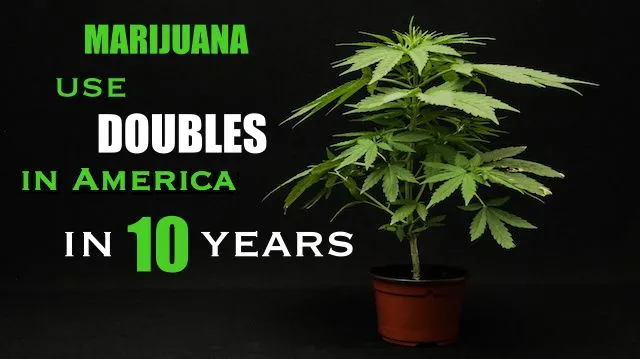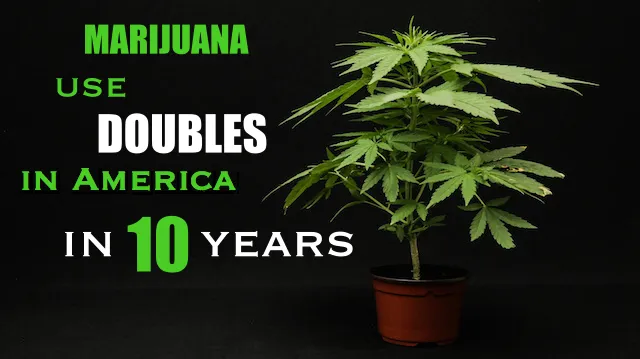
- Share on Facebook51
- Share on Pinterest
- Share on Twitter
A study published this month in JAMA Psychiatry found that marijuana use is up considerably from data collected between 2001 and 2002. The study conducted by the Department of Psychiatry, College of Physicians and Surgeons, at Columbia University found that the number of people having a toke has doubled in 10 years.
The research was sponsored by the National Institute on Alcohol Abuse and Alcoholism, and involved over 36,000 “face to face interviews.” The data, compiled from the “National Epidemiologic Survey on Alcohol and Related Conditions,” compared marijuana use from 2001 to 2002 and 2012 to 2013. The study found that the percentage of American adults who smoked marijuana was 9.5 percent between 2012 and 2013. This was a significant increase from 4.1 percent recorded between 2001 and 2002.
The authors of the study outlined the problem of “marijuana use disorders” in their research conclusion. These disorders cover a wide range of adverse effects that marijuana users may experience over time, including cognitive decline, auto accidents and even poor quality of life. The study did note, however, that the percentage of marijuana use disorders decreased despite the rise in the amount of people using marijuana. They concluded that between 2001 and 2013, the prevalence of marijuana use disorders fell from 35.6 percent to 30.6 percent.
What does this new data tell us? That Americans are all stoned? Not quite, but the use of marijuana is quickly becoming commonplace in American culture, which is beginning to take on an Amsterdam-like feel. Twenty-three states now allow medical marijuana use and four of those states have legalized marijuana for recreational use.
Laws are changing and the once taboo, negative vibes surrounding marijuana are quickly going up in smoke, giving way to a more accepting attitude toward the plant and a clearer understanding of its medicinal properties. The National Institute on Drug Abuse states that delta-9-tetrahydrocannabinol, or more commonly known as THC, “increases appetite and reduces nausea.” It continues, “The FDA-approved THC-based medications are used for these purposes. THC may also decrease pain, inflammation (swelling and redness), and muscle control problems.”
 A study published in the Journal of the American Heart Association (2014) analyzed marijuana use and its positive-versus-negative attributes. The study concluded, “In summary, there is clear clinical evidence to suggest a therapeutic benefit of inhaled marijuana for the management of a number of chronic, debilitating conditions. However, clinical evidence also suggests the potential for serious cardiovascular risks associated with marijuana use, including myocardial infarction, serious cardiac arrhythmias, stroke, and even death.”
A study published in the Journal of the American Heart Association (2014) analyzed marijuana use and its positive-versus-negative attributes. The study concluded, “In summary, there is clear clinical evidence to suggest a therapeutic benefit of inhaled marijuana for the management of a number of chronic, debilitating conditions. However, clinical evidence also suggests the potential for serious cardiovascular risks associated with marijuana use, including myocardial infarction, serious cardiac arrhythmias, stroke, and even death.”
On the surface, it may seem that marijuana use is an effective therapeutic tool, but there are those who warn that it may cause serious cardiovascular events. However, it’s important to also take a look at the many other risk factors associated with cardiovascular disease. Obesity, tobacco use, heavy alcohol use, and lack of physical activity may be far more detrimental than marijuana use when it comes to cardiovascular disease.
The legalization of marijuana in states across America is a hot topic, however, it’s hard to refute its growing popularity. As marijuana use becomes more mainstream in America, how do you think it will affect health?
-Stephen Seifert
Stephen Seifert is a writer, professor, adventurer and a health & fitness guru. His flare for travel and outdoor adventure allows him to enjoy culture and traditions different than his own. A healthy diet, routine fitness and constant mental development is the cornerstone to Stephen’s life.
Sources:
http://archpsyc.jamanetwork.com/article.aspx?articleid=2464591
https://www.drugabuse.gov/publications/drugfacts/marijuana-medicine
http://jaha.ahajournals.org/content/3/2/e000904.full
- Share on Facebook51
- Share on Pinterest
- Share on Twitter

